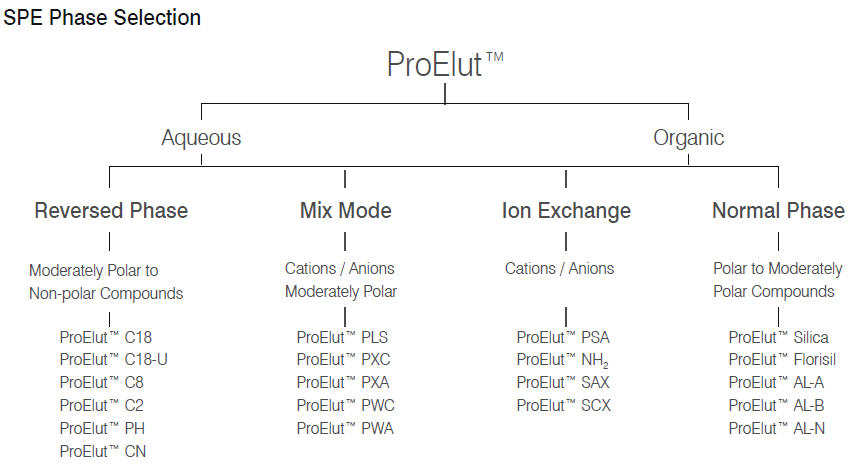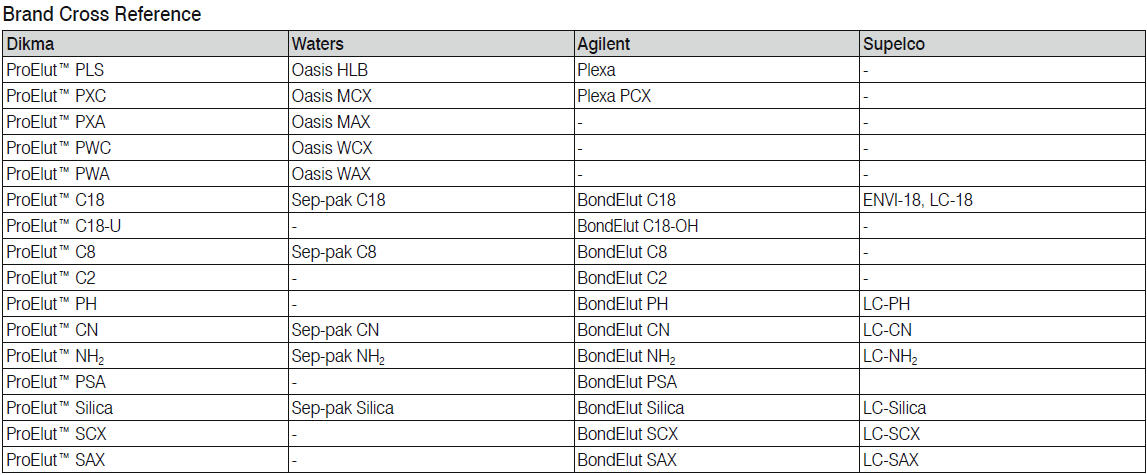- Home
- Products
- Sample Preparation
- ProElut™ SPE Cartridges
- Silica-based Sorbents
- ProElut™ C18-U
ProElut™ C18-U
ProElut™ C18-U
ProElut™ C18-U has a non-endcapped octadecyl bonded phase that enables the silanols on the silica surface to be more active. However, the well-controlled silanol activity exhibits excellent selectivity towards polar compounds, especially amines such as tetracyclines.
| Base material | Spherical silica, Particle Size: 50 μm, Pore Size: 60 Å, Specific Surface Area: 500 m2/g |
| Functional group |
 |
| Endcapping | No |
| Carbon loading | 17% |
| Retention mechanism | Reversed phase |
| Application | Similar to ProElut™ C18, but with enhanced retention for polar compounds |
.jpg)
Choosing a SPE Product
1. Characterize the sample. Factors such as the analyte’s polarity relative to the matrix, the presence of charged functional groups, solubility, molecular weight, etc., determine how strongly the analyte is retained by the packed bed.
2. Select a retention strategy. Two approaches are possible: retain interfering compounds while the analyte passes through, or retain the analyte while interfering compounds pass through. This second approach allows concentration of the sample during analyte elution.
3. Select proper packing type and bed volume. Choosing the packing material with the proper selectivity results in the cleanest extract with the highest recovery.
Poor sample recovery often occurs when the packed bed dimensions are not optimized. Too large of a bed volume results in an incomplete elution while too small of a bed volume results in an incomplete retention. Due to the unknown composition of many samples, experimentation may be required to determine the optimum bed dimensions for an application. Start with an intermediate bed volume, such as 200 mg or 500 mg. If you observe complete retention, you may be able to use a smaller bed volume and elution volume. If you observe incomplete retention, you will need to use a larger bed volume and elution volume.
4. Select suitable conditioning, wash, and elution solvents. Consider the solvent strength relative to the packing material. The final conditioning solvent should be weak, so as not to act as an eluting solvent. Buffers should be used to control ionization of potentially charged compounds. Wash solvents should remove weakly retained interferences without being strong enough to elute the analyte. Elution solvents should be strong enough to completely elute an analyte in a small volume.


General SPE Procedures
Reversed Phase
(extraction of hydrophobic or polar organic analytes from aqueous matrix)
A. Conditioning
Rinse tube with 3 - 5 mL of methanol follow by 3 - 5 mL of deionized water / buffer (do not allow tube to dry before next step).
B. Sample Application
Apply sample to the top of the tube and draw through the packing bed.
C. Tube Wash
Wash with 5 mL of a polar solvent if analyte is to be retained (deionized water, buffer or aqueous / organic mixtures are most often used).
D. Elution
Elute analyte into a collection tube with 1 - 5 mL of a non-polar solvent.
Normal Phase
(extraction of polar analytes from non-polar organic solvents)
A. Conditioning
Rinse tube with 3 - 5 mL of non-polar solvent.
B. Sample Application
Apply sample to the top of the tube and draw through the packing bed.
C. Tube Wash
Wash with 5 mL of a non-polar solvent if analyte is to be retained.
D. Elution
Elute analyte into a collection tube with 1 - 5 mL of a polar solvent.
Ion Exchange
(extraction of charged analytes from aqueous or non-polar organic samples)
A. Conditioning
Rinse tube with 3 - 5 mL of deionized water or low ionic strength buffer (10 mM).
B. Sample Application
Apply sample to the top of the tube and draw through the packing bed (ion exchange kinetics is slower than reverse or normal phase, so keep the flow slow).
C. Tube Wash
Wash with 5 mL of deionized water or low ionic strength buffer.
D. Elution
Elute analyte into a collection tube with 1 - 5 mL of buffer at high ionic strength (0.1 - 1 M) or modified pH (pH such that the analyte is uncharged).
USA
11 Orchard Road, Suite 106
Lake Forest, CA 92630, USA
Tel: 949-716-5810
Fax: 949-716-5811
Toll-Free: 1-877-328-8348
Email: sale@dikmatech.com
Business hours: 9 AM - 5 PM PST
Canada
255 Shields Court, Unit A
Markham, ON L3R 8V2, Canada
Tel: 905-944-8066
Fax: 905-944-0181
Toll-Free:1-866-889-9072
Email: sales@dimaglass.com
Business hours: 9 AM - 5 PM EST
Korea
FRABJES WANDELN
E-mail: wyoh@frabjes.com
